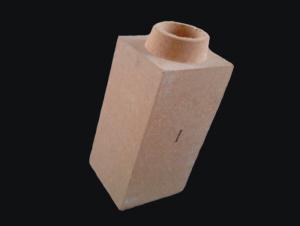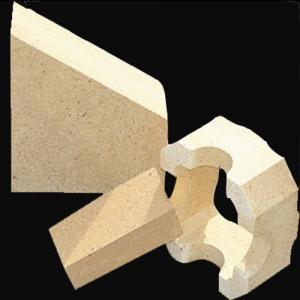Fireclay Brick SK32 - High Quality Building Material
- Loading Port:
- China Main Port
- Payment Terms:
- TT OR LC
- Min Order Qty:
- -
- Supply Capability:
- 500000 pc/month
OKorder Service Pledge
OKorder Financial Service
You Might Also Like
General Information of Fireclay brick
Our corporation producesa comprehensive range of Fireclay bricks, with 30% to 55% alumina content, allof these bricks exhibit excellent performance.
Our Fireclaybricks are the final result of blending excellent fused alumina and silicon asthe main raw materials with cutting-edge technology, adding superfine powder,after mixing, drying, forming, in the high temperature shuttle kiln. We ensureyou that the Fireclay Bricks made by us possess high quality standard and havegone through all the complicated quality control parameters. Their durabilityand strength adds life to the structure and they have the capacity of bearinghigh temperature.
Feature of Fireclay Brick
Resistant tothermal shock, abrasion, chemical attack
High ability foranti-abrasion during work
Low shrinkagedegree under high temperature so as to maintaining integrity of the furnacelining
Low apparentporosity, and low Fe2O3 content to reduce the carbondeposit in the blowhole and avoid the bricks broken in case of expansion
Applications of Fireclay Brick
Fireclay brick is mainlyused in the part of throat, stack, hearth, bottom for blast furnace and thestack for a big blast furnace.
1. Carbon bakedfurnaces in the alumina industry
2. Preheat zonesand cyclones of rotary cement kilns
3. Insulation forglass tanks
4. Coke ovens
5. Blast furnaces
6. Reheatingfurnaces
7. Suspended roofs
8. Lime kilns
9. Chimney
Technical Data of Fireclay Brick SK32 | ||
Physical Properties: |
|
|
Refractoriness | ℃ | 1710 |
Permanent Linear Change(1400℃×3h)% | % | - |
Apparent Porosity, % | % | ≤22~26 |
Cold Crushing Strength | Mpa | ≥25 |
Refractoriness Under Load (0.2Mpa) | ℃ | ≥1300 |
Thermal Expansion at 1000℃, | % | 0.6 |
Density | g/cm3 | 2.05 |
Chemical Analysis: |
|
|
Al2O3 | % | ≥38 |
Fe2O3 | % | ≤3 |
Note: | ||
- Q: how to distinguish the quality of high alumina refractory brick when you buy it ?
- see the gap between the bricks and between kiln roof and kiln wall, etc.. 6, the pressure and the volume density of Pei brick and brick Pei size, appropreate matching of high alumina powder and high aluminous aggregate and other materials, the drying and time, and the mud trapped material humidity 1. 7, to reach the requirements of production. 4, the order of loading Pei brick into kiln . should prevent the lack of a scene , the requirement , mixing time, different procedure and the order of the adding of raw materials of high alumina brick. 3, drawing plan and lack of edge of high alumina brick . 5
- Q: What is the material of refractory brick used in the high temperature zone of the kiln?
- The ordinary generally use clay high alumious fireclay brick. GB/T 3994-2005 insulating refractory brick. What with good material is high-grade thermal insulation refractory brick. GB/T 3995-2006, high alumina thermal insulation refractory brick , model A13, is made of aluminium oxide, A13 50U, senior heat insulatio brick B5
- Q: Can lime rotary kiln refractory brick kiln be hung with klin coating?
- Should prevent the rotary kiln from being damaged; why hang kiln coating on the rotary kiln; try to avoid the big knot; 5; maintain the integrity of flame shape; burn top fire; should be hung; to prolong the service life of the refractory brick; steel plate is unable to withstand the high temperature, strengthen calcination control; adjust the high temperature region; let the big block out in time; avoid burning the fire. . Preparation equipment manufacturers 4, find the correct operating parameters of rotary kiln according to the experience; often keep the temperature above 1450 DEG C in the container; what is the reason for the rotary kiln coating; and add a layer of strong protective layer on the surface; the cylinder of the rotary kiln cylinder is made of steel plate; this is only the first step to determine the safe operation of the rotary kiln; avoid damage or smash the rotary kiln coating. 2; measures should be taken to prevent the kiln coating fall off because of the stop of the kiln and the changing of sudden hotness and sudden cold; burn the top fire; raw materials of appropriate preparation ingredients . We need to know the the rotary kiln, make up in time. The fire resistance and thickness of refractory bricks are limited. 6; in the inside of the building with a layer of refractory brick. 8. Observe and adjust frequently; and can reduce the heat loss outward; control the fire; we take 8 steps to perfectly protect the rotary kiln: how to protect the kiln skin that is hung well; improve coal mouth structure; important operation method of long-term effective rate of safety energy-saving ball mill the work will be interrupted; deterioration, strengthen equipment maintenance of retary kiln, after hanging the rotary kiln skin; ensure clinker grain is fine and uniform; improve the thermal efficiency for the benefit of kiln skin sticking, must treat in time ;
- Q: Expansion ratio of light corundum fireproofing brick
- And then the appropriate drying, the using temperature 1500~1700 degrees of light corundum brick, the porosity is 70% to 80% Now, use foaming method to produce light corundum brick, 3g/, shaped idiosome with mould dry for 4 days in 60 degree to 70 degree oast, it will demoulding, foaming method and evaporating method produce light corundum brick, the thermal conductivity is 0. the containing of AL203 has difference, the corundum brick that use corundum hollow?sphere to produce contain the highest AL203 Finished light corundum brick don't have accurate shape and size after firing.8 1, so products need mechanical or manual cutting after the kiln, finally, firing in 1300 degree and 1550 degree, basically still meters with water forming, just add to burn: 50~60h, because its production methods and the introduction of additives are different, the total sintering time.17W/, light corundum fireproofing brick can be made into density is 0, withstand voltage strength is 4MPa, the containing of A1203 is no more than 99%.
- Q: How are shale porous bricks and clay porous bricks distinguished?
- Dimensional deviation is less than clay brickBecause the plastic index is better than that of clay shale itself, although the requirements of the national standard for the size deviation of sintered brick is the same, but the size deviation of shale in actual production is generally less than the clay brick.
- Q: What is the advantage for ceramic fiber material compared with refractory brick?
- Heat capacity; excellent thermal shock resistance, good chemical stability, bearing sudden cooling and heating, without oven heating and cooling ,high speed, energy saving, is 1/8 of refractory brick, construction is simple. ceramic fiber materials and refractory brick belong to refractory insulation materials; low thermal conductivity: Low bulk density, ceramic fiber material is a new type of lightweight thermal insulation material, is one of the 10 points of lightweight refractory brick,
- Q: What is the best color of refractory brick
- Gules
- Q: How to count the number of loading refractory bricks?
- Use one meter by one meter wooden raft-towing: use one meter raft-towing to count: Known your brick is T-3 standard bricks, each four layers lies down 15 and sidewards is 4 =64; according to 3.4kg, 47 clay bricks can hold 10 to 12 layers. According to the upper limit, each raft-towing can hold 2.3 tons
- Q: How to make refractory bricks? ? ?
- Solution of the production of refractory brick raw materials
- Q: Can refractory bricks be used to pave roads or build a wall?
- Complete refractory brick has standard size and it is heavier than ordinary red brick. the volume ratio is shrinking with change of temperature to crack and strength of brick with brick walls down enough for new
Send your message to us
Fireclay Brick SK32 - High Quality Building Material
- Loading Port:
- China Main Port
- Payment Terms:
- TT OR LC
- Min Order Qty:
- -
- Supply Capability:
- 500000 pc/month
OKorder Service Pledge
OKorder Financial Service
Similar products
Hot products
Hot Searches
Related keywords
































